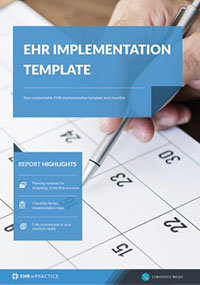A template for your EHR project implementation timeline
Given the number of variables that can either increase or decrease the time needed for an EHR implementation the typical time needed for implementation vary according to by setting and by product. As such, one cannot easily find a standard timeline for EHR implementation.
However, the steps involved in implementation can be analyzed to provide a clear picture as to the distribution of the implementation workload and provide a clear vision as to the steps in the process that can lengthen the implementation.
The following points highlight the main steps and their impact on the overall EHR project timeline to get from vendor selection to go live.
1. Demonstrations and evaluation
Time: two weeks to three months
How long the EHR demonstration and evaluation take, depends on the number of vendors being auditioned and how the demonstration and evaluation process is conducted. Some vendors offer a remote demonstration of their product whereas others allow potential purchasers to “test drive” their product in house.
Use this customizable EHR implementation template to plan and schedule your EHR implementation
The time this phase takes depends on the amount of research and consideration invested by the consumer and the ability of the vendor to accommodate such requests. With favorable scheduling this process should add no more than three months to your EHR project timeline.
2. Making a final selection decision
Time: one month to three months
The process of identifying and selecting an EHR vendor represents a portion of implementation that can hold serious long-term consequences if not properly conducted. As such, the process of EHR selection and negotiation is perhaps one of the more research-intensive and deliberative portions of implementation.
When considering all of the steps, practices are well advised to allow adequate time to complete this task in a thorough fashion. If a practice relies on an implementation team to arrive at a selection decision and will consider the input from stakeholders, at least, a month (or more) should be allotted to complete this phase of your EHR project timeline.
3. Recruiting an EHR implementation team
Time: one to two weeks
This first EHR implementation step is something you can move relatively quickly on. You’ll possibly be able to re-recruit your user group representatives from your selection team. If not, you still have a basic outline of what your team should look like, and the basic functions it should perform.
Use this EHR implementation team list template to recruit your team:
Management
- Project manager:_____________________
- C-level sponsor:_____________________
Technical
- Application analyst:_____________________
- Application developer:_____________________
- Application test engineer:_____________________
- Consultant:_____________________
User group representatives
- Physician:_____________________
- Nurse:_____________________
- Counsellor/therapist:_____________________
- Occupational therapist:_____________________
- Midwife: _____________________
- Administrative team:_____________________
- Billing department:_____________________
- Practice management:_____________________
4. Creating a change management plan
Time: one to six months
Whether the planning phase occupies the largest portion of the budgeted time spent on implementation depends on organizational realities. Complex organizations such as a hospital system with a number of departments will clearly require more intensive implementation planning; whereas a smaller ambulatory practice will require less planning.
The length of implementation planning can also be shortened if a clear plan can be developed; however if the plan is vague or requires a number of contingencies this stage can take longer than anticipated. Given its importance the eHR project timeline for planning should be viewed as long as it takes to fully map out the process. In some cases a practice could complete this phase in a month, larger organizations may need up to six months.
GET EHR RESEARCH & KNOWLEDGE RIGHT TO YOUR INBOX
Covering the key issues faced by businesses selecting and implementing EHR.
5. Fine-tuning an EHR implementation budget
Time: one week
A relatively short step, as you’re probably not creating anything from scratch here. During your initial EHR selection discussions, you will have worked out a relatively structured budget for the project and estimated costs relating to implementation.
Now that you’ve selected your EHR vendor, you’ll have exact values for implementation fees and services, and will have a better idea of the amount of staff overtime required to maintain throughput and services during the implementation period.
Go through the costs you forecasted during selection and update accordingly. These should include:
- Vendor implementation fees: $________
- External consultancy costs: $________
- Development and customization: $________
- Employee overtime: : $________
- Extra admin staff: : $________
6. Data audit and migration
Time: two weeks to two months
Before transferring your patient data to your new EHR, it is a good idea to audit the data in your legacy system (if you have one) or paper records to ensure that it is up-to-date. This is where you need to spend most of your time on this step - the actual process of migrating your data from one EHR to the other can be done in a matter of hours.
Conducting a data audit at this point ensures that all data transferred to your new EHR at this point is compliant with industry regulations, and reduces the likelihood of user error once the system is set up. According to some auditors, this process would usually take between two to three weeks, although particularly large practices or hospitals should schedule longer.
7. Software testing
Time: two weeks to two months (or more, if any major issues)
This is probably the hardest implementation stage to offer a fixed timescale for as it entirely depends on the issues the first round of testing throws up. A small practice whose first round of testing throws up no major bugs might be done in as little as two weeks. On the other hand, for larger practices and/or those with major issues to fix, the process could take a couple of months or longer.
One way of streamlining the process is to deploy an automated testing solution for your EHR. These can automate some repetitive-but-necessary tasks in an existing testing process, or perform additional testing that would be difficult to do manually. If you choose to go down this route, make sure you adjust your budget for extra software solutions.
8. Training and preparation
Time: dependent on training method. NB: this can run concurrently with other steps. While you should allow adequate time for training, a three week series of seminars (for example) does not necessarily have to add three weeks onto your total implementation time.
Implementing a rigorous training program on the incoming EHR serves as the backbone of a thorough EHR implementation. As such, many practices will view the training component of implementation as one of the variables that can be controlled when trying to avoid workflow disruptions and overall lost productivity.
As an example, a 2010 study of 26 Texas-based, five-physician primary care practices found an average of 52.5 hours of training was required across the organizations, while the system’s physician end-users received an average of 23.9 hours of training. As such, one can devise a time estimate by taking these averages and increasing them in light of the organization’s size.
The timetable below helps you keep track of when and how your key user groups are being trained. Customize it to your key user groups.
| User group | Method of training | When |
|---|---|---|
| E.g: billing department | E-learning modules |
Ongoing. Deadline 18/03 |
| E.g: nurses | 3 seminars for different shifts | 21/03 |
9. The go-live
Time: one day
The go-live is the culmination of the preceding months of hard work, but is not a particularly extensive implementation step in itself. You should have planned extensively for this moment during your pre-implementation planning sessions, and you should aim to complete it in one (potentially frantic and busy) day.
It’s a good idea to create a detailed timetable and roadmap specifically for go-live activities. This should include:
- Patient communication guidelines (including expected downtime)
- Staff scheduling including required overtime or temporary staff
- Modification of appointments and scheduling
- Reporting processes for system and project evaluation (see step 8)
- In-practice communications (signs on notice boards etc.)
- Network speed and reliability checks
- Data backup processes
10. EHR performance evaluation
Time: continuous, though you should review at set points post-implementation
Time is money as the old saying goes. Accordingly, time spent implementing an EHR should be viewed as an investment.
Before go-live, ensure that you and your team agree on a collection of metrics by which you measure success in your investment. Then, identify timed stages for partial completion of your end-goal. For example, you might want to increase patient throughput by 10% as a result of implementing new EHR software. Obviously, this isn’t going to happen immediately post implementation, so create a timeline to keep you on-track. In this example, this could look like this:
- One month post implementation: patient throughput back to pre-implementation levels
- Six months post implementation: patient throughput increased by 5%
- A year after implementation: patient throughput increased by 10%
You can use the table below to map out these goals:
| Goal | Target completion date (weeks post implementation) | Complete? (Y/N) |
|---|---|---|
| E.g: patient throughput restored to pre-implementation levels | 1 | Y |
| E.g: patient throughput increased 5% on pre-implementation levels | 6 | N |
Unfortunately, there is not a standard formula for determining the EHR project timeline for implementation; however understanding the potential problem areas in an EHR implementation can provide a great deal of insight into what portions will consume the most amount of time. For example, a practice who will be faced with a range of viable EHR options may want to spend more time on selection, whereas a practice whose staff may be averse to a new EHR may spend more time on training and orientation.
Free white paper

EHR Implementation Template
Get all the planning tools you need to make your EHR implementation a success

Featured white papers
-

EHR Implementation Template
Get all the planning tools you need to make your EHR implementation a success
Download -

EHR implementation: 6 steps to success
Step-by-step information on how to implement EHR effectively
Download -

EHR Vendor Directory
Get the most up-to-date directory of EHR software vendors. Find the best software for your practice.
Download
Related articles
-

How much EHR costs and how to set your budget
Build a realistic, workable budget for your EHR project with this guide
-

EHR Implementation Plan: Your 8-Step Checklist
Your comprehensive checklist for creating an EHR implementation plan.
-

5 important areas of EHR training during implementation
Successful EHR implementation is not possible without crucial EHR training

